Please
go to the updated Orion Zone website to read this article:
http://www.theorionzone.com/azpyramids.htm
The Great Pyramids of Arizona
(Please
be patient while graphics are loading.)
by
Gary A. David
Copyright
© 2002-2005 by Gary A. David.
islandhills@cybertrails.com
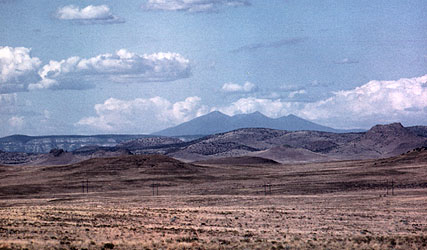 |
| The
San Francisco Peaks from a distance of over 60 miles. |
In a recent issue of Archaeology
magazine Dr. Farouk El-Baz from Boston
University suggests that the three major pyramids of the Giza Plateau may
have been modeled after the naturally occurring, conical hills found near the
Kharga Oasis almost 150 miles west of Luxor. He also notes that the hieroglyph
meaning 'desert hills' has a pointed shape. 1.
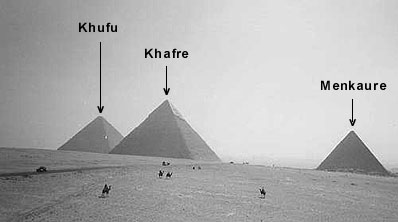 |
| The
major pyramids at Giza. Khafre is actually shorter than Khufu but appears taller
because it is built on higher ground. |
On the other side of the globe upon the high desert of American Southwest
three great mountains rising out of the San Francisco Peaks eerily echo the Egyptian
triad. The basaltic cinder cone of Humphreys Peak (the highest point in the Arizona,
12,633 feet in elevation) dominates this arid landscape. The slightly lower Agassiz
Peak (12,356 feet) is about a mile-and-a-half due south, while Fremont Peak (11,969
feet) rests a mile farther to the southeast.
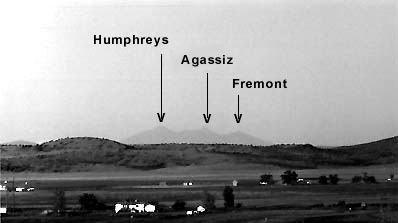 |
These mountains are the winter home of the Hopi kachinas.
Rather than gods per se, these intermediary spirits can take the form of any object
or energy in the universe. Shortly after the winter solstice they travel to the
three Hopi Mesas about 70 miles to the northeast. There these divine beings assist
in the germination and growth of corn, squash, beans and other crops during the
spring and early summer.
From late April until July Hopi men don kachina
masks and costumes, not to impersonate the spiritual helpers but to actually become
them. Dancing in the village plaza from dawn until dusk under the brutal desert
sun, they coax moisture from the few clouds drifting overhead. Upon the arrival
of the monsoons in mid to late July, the kachina spirits return to their mountain
habitat for the remainder of the year.
The relationship between the Egyptian
desert hills and the three monumental pyramids may be similar to that between
the volcanic mountains of Arizona and the three major Mesas where the Hopi settled
about 900 years ago. Although the Mesas are natural landforms rather than human-made
structures, the villages built atop them in effect sanctify the surrounding geography.
The center of the Hopi world, called Tuuwanasavi, is comprised of the First
Mesa, Second Mesa, and Third Mesa. The Egyptian term for the underworld is Tuat,whose
gateway is Giza. Like the Giza pyramids, the Tuuwanasavi corresponds to the three
stars in the belt of Orion, which is the visual focus and spiritual heart of the
constellation. (Go to the Overview article on this
Web site. Also see my articles regarding the Orion correlation of Arizona in Issue
37 of Atlantis Rising and Volume
7/Number 46 of Ancient American.)
The Mesas function as natural ziggurats, lifting the supplicant closer to the
celestial forces that must be appeased in order to gain the blessing of rainfall.
Scholar Vincent Scully explains the cultural significance of these landforms.
“Once we see the
mesas as more than simply man-chosen but almost literally man-constructed --at
the very least, man-finished, as the Hopi see them-- their true scale in Hopi
culture opens to our understanding. We remember moreover that there is no semantic
distinction for the Hopi between the works of nature and those of mankind. Hence
the collaboration of the mesas is between commensurable beings. The Hopi are one
with the rock.” 2.
For the Hopi the choosing and finishing of the Mesas are
tantamount to the construction of the true pyramids of Egypt or the stepped
pyramids of Mesoamerica.
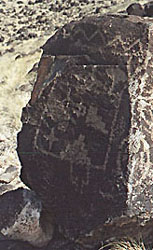 |
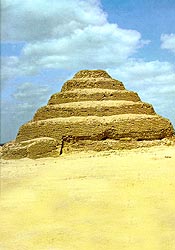 |
|
Star
(cross on left) and stepped petroglpyh. |
Stepped
pyramid at Saqqara. |
The
ancient Hopi petroglyph representing either a mesa or a rain cloud is the stepped
pyramid, the exact copy of the Egyptian double staircase hieroglyph. The Egyptian
Aatt means 'necropolis of the pyramid region' and 'Other World'. Both the
pointed desert hills hieroglyph mentioned above and the double staircase hieroglyph
were used to form this word. 3.
The otherworldly kachinas soar from their Mesas to the terraced storm clouds
in the same way that he souls of the pharaohs took flight from their pyramids
to the stars. The Hopi word aatsava means 'between' and the related word
atsva means 'above' or 'on top', thereby stressing the verticality of the
mesa/pyramid.
Incidentally,
the primary Egyptian example of the stepped pyramid is found at Saqqara. The Hopi
word saaqa means ladder or stepladder'.
In both the Egyptian and the Hopi cultures, pyramids have an avian association.
The Bennu bird,
also known as the phoenix, was sometimes depicted as a gray heron perched atop
a pyramid or an obelisk. Periodically regenerated from its ashes, this sacred
fowl is a primary symbol of eternal life. The Bennu was even instrumental in the
creation of the cosmos. The Shu Texts describes “...that breath of life which
emerged from the throat of the Benu Bird, the son of Rę in whom Atum [the
sun-god] appeared in the primeval nought, infinity, darkness and nowhere.” 4.
Rising
from the primordial abyss, the hikę (life-breath) is carried in the beak
of the sacred bird of rebirth. It is perhaps more than a coincidence that the
Hopi word hik’si echoes both phonetically and semantically the Egyptian
word hikę.
The powerful image of a bird perched on the apex of
a pyramid also appears on a Hopi artifact. In the early twentieth century near
the present town of Winslow, Arizona the renowned archaeologist Jesse Walter Fewkes
unearthed a stone slab covering a grave at Chevelon Ruin. 5.
On one side of the painted slab a white rectangular border with black
on the outside encloses three isosceles triangles or pyramids of nearly equal
size. On a yellow background each of these black pyramids contains a white square
located near the base. A red bird, either a macaw or a parrot, is perched facing
to the right atop all three pyramids. Each of the stylized birds has a triangular
body, the base of which forms its dorsal side. The body’s apex (where its feet
would be) touches each pyramid’s apex. Only the center bird has eyes. They all
have bifurcated tails and curving beaks. The four colors used on this slab are
the traditional Hopi directional colors: yellow (northwest), black (southwest),
red (southeast), and white (northeast).6.
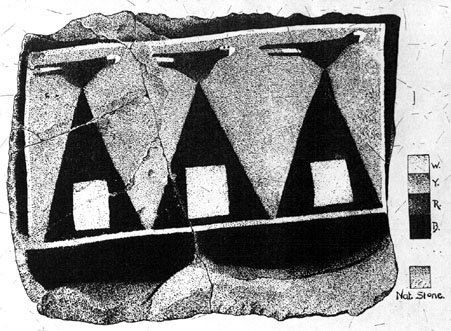 |
| Stone
slab found at Chevelon Ruin near Winslow, Arizona. |
What
is the meaning of these figures? Fewkes says that the triangles are simply rain
clouds. The white square at the heart of each pyramid signifies inner space, perhaps
an Underworld of sorts. The three pyramids possibly designate the three major
promontories in the San Francisco Peaks as well as the three Hopi Mesas.
The exotic parrot or scarlet macaw represents the moisture of the tropical
jungles far to the southeast, the direction symbolically implied by their redness.
This is also the region of the Mayan stepped pyramids. Used in prayer stick making
and other ceremonies, the multi-hued feathers of these birds may symbolize the
nadir, the Underworld direction of “many colors.” 7.
Whole bodies of both parrots and macaws have been found in burial sites throughout
the Southwest.
Fewkes also discovered other grave slabs at Chevelon with
circular holes ranging in size from a broomstick to an arm’s width worn into them.
Somewhat condescending vis-ŕ-vis the modern Hopi, he remarks on their purpose:
“Explanations more or less fanciful have been suggested for these perforated stones,
one of which was that the rock had been placed above the body and the hole in
it was for the escape of the soul or breath-body.” 8.
Given this evidence, the three birds atop their pyramids in Arizona most likely
performed same function as did the journeying soul of the Bennu in Egypt-- the
omnipresent quest for immortality.
The Bennu iconography is also associated
with the Benben,
a black conical stone, possibly meteoric, used as a pyramidion, or apex of a pyramid.
The Egyptian word ben denotes both the nominative 'seed' or 'semen' and
the infinitive 'to copulate' or 'to impregnate'-- all particularly apropos of
the phallic obelisk.
9.
In addition, the cognate ben-t means 'cincture, belt, girdle' 10.
and refers to Orion’s belt. Alnitak, the most eastern star of the Belt (corresponding
to the Great Pyramid, or Khufu), literally means 'the Girdle'. Mintaka, the
most western star (corresponding to Menkaure), is called 'the Belt'. 11.
As with every truly divine omnipotence, the positive aspects are counter-balanced
with the negative. Hence the word ben also means 'evil, wickedness', and
the words ben-t or benut also refers to 'pustule, boil, abscess,
or pus' 12. --all of which are attributes
of the Hopi god of the Underworld and death named Masau’u. No 'b' sound exists
in the Hopi language, but the related word poengoe means 'boil' or 'abscess'.
Whether or not the pyramid-shaped hills of the Sahara served as models
for the massive structures at Giza is still debated. Because the winter and summer
homes of the kachinas are the San Francisco Peaks and the Hopi Mesas respectively,
this tribe most likely acknowledges the relationship between the three natural
mountains and the three ceremonialized Mesas. Similarly, these Mesas reflect the
three belt stars of Orion.
Correlations abound, both on earth and in
heaven. To live between the two realms upon this vast desert is to feel deep in
one’s bones the hermetic maxim “As above, so below.”
an
excerpt from The Orion Zone: Ancient Star Cities of the American Southwest
Copyright
© 2002-2005 by Gary A. David. All rights reserved
Any use of text
or photographs without the author's prior consent is expressly forbidden.
Contact: e-mail islandhills@cybertrails.com
End Notes
1.
Archaeology, Volume 54, Number 2, March/April 2001.
2. Vincent
Scully, Pueblo: Mountain, Village, Dance (Chicago: University of Chicago
Press, 1989), pp. 379-380.
3. A. E. Wallis Budge, An Egyptian Hieroglyphic
Dictionary, Vol. 1, (New York: Dover Publications, Inc., 1978, 1920), p. 113.
4. R.T. Rundle Clark, Myth and Symbol in Ancient Egypt (New York:
Thames and Hudson, 1991, 1978, 1959), pp. 245-246.
5. Occupied between
A.D. 1280 and the 1380s, this 300-room pueblo was a satellite of the much larger
Homol’ovi Ruin
located 12 miles to the northwest. Homol'ovi corresponds to Betelgeuse, Orion’s
right shoulder. Chevelon Ruin is due south nearly 60 miles from the Hopi village
of Shungopovi
on Second Mesa, which corresponds to Alnilam,
the middle star in Orion’s belt. Nearly 60 miles due north from Shungopovi is
the cliff dwelling at Betatakin
Ruin, which corresponds to Rigel, Orion’s
left leg. The method for establishing this precise north-south line stretching
120 miles is unknown. In addition, the line between Chevelon and Shungopovi forms
the base of an equilateral triangle, the apex of which is nearly 60 miles to the
west at Sunset
Crater National Monument, a volcanic cinder cone 1,000 feet high. It erupted
intermittently between A.D. 1064 and circa 1250 and then became dormant. (See
photo below.)
6. Jesse Walter Fewkes, “Two Summers’ Work In Pueblo Ruins,”
Twenty-Second Annual Report to the Bureau of American Ethnology, 1900-1901
(Washington, D.C.: Smithsonian Institute/Government Printing Office, 1904), pp.
104-106 and Pl. XLVI.
7. Watson Smith, When Is a Kiva and Other Questions
About Southwestern Archaeology, Raymond H. Thompson, editor (Tucson: The University
of Arizona Press, 1990), p. 150.
8. Fewkes, Twenty-Second Annual
Report, p. 106.
9. Robert Bauval and Adrian Gilbert, The Orion
Mystery: Unlocking the Secrets of the Pyramids (New York: Crown Publishers,
Inc., 1994), pp. 16-19, pp. 197-204.
10. Budge, An Egyptian Hieroglyphic
Dictionary, Vol. I, p. 217.
11. Richard Hinckley Allen, Star
Names: Their Lore and Meaning (New York: Dover Publications, Inc., 1963, 1899),
p. 314.
12. Budge, An Egyptian Hieroglyphic Dictionary, Vol.
I, p. 216 and p. 217.
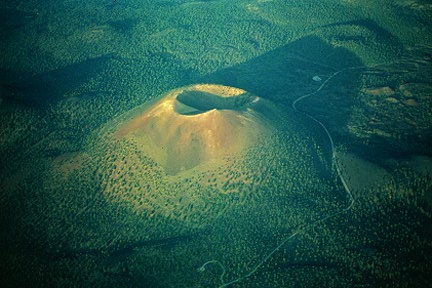 |
| Sunset
Crater Aerial photo by Wendell Duffield, U.S. Geological Survey. |